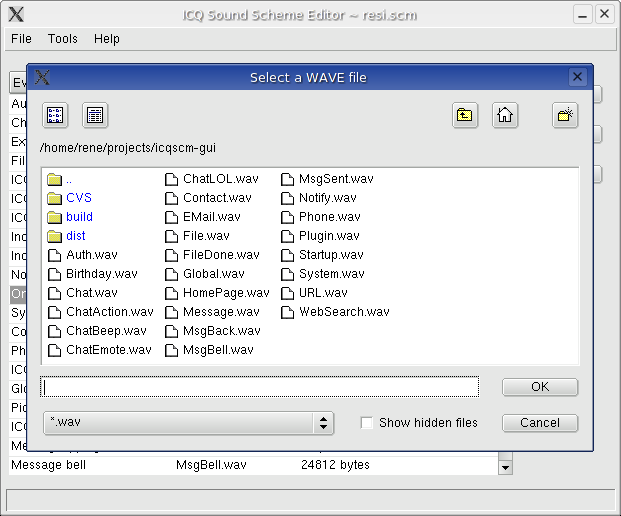The times of quiet (- Linux, Windows -) ICQ clients are over! This project delivers both a command-line and a GUI based editor for ICQ sound scheme files.
With those tools you can extract WAVE sound files from ICQ sound scheme files (- check out sounds.icq.com -) and then use them in your favourite ICQ client (like licq, gnomeICU, etc). Of course, this wouldn't be called an editor if you weren't able to create new sound schemes or edit existing ones with it.
For Windows users (- who apparently are still able to live with the immune system deficiency of their operating system -), an "all-in-one" executable version is provided in a .ZIP archive; Linux users will have to install python and for the GUI: wxPython. Both packages come with any decent Linux distribution and can be installed without any hassles; no configuration whatsoever is required.
For download and installation instructions see the DOWNLOAD section. If you are interested in the format of ICQ sound scheme files, check the Documents section.
Icqscm provides a command line interface to ICQ sound scheme files (hundreds of which can be downloaded from the ICQ website).
Main purpose of icqscm: Extracting the WAVE files out of ICQ sound scheme files.
However, with its tar like command line options it is easily possible to update existing sound schemes or even create new ones. A GUI version is available seperately.
Here is the usage output of icqscm:Usage: icqscm.py [OPTION]... [FILE]...
Examples:
icqscm.py -tf
my.scm #
lists all files in my.scm
icqscm.py -xf my.scm Email.wav #
extracts Email.wav from my.scm
icqscm.py -C /tmp -xf
my.scm # extracts all files from my.scm into /tmp
icqscm.py -cf my.scm
*.wav # creates my.scm and adds all WAVE files
icqscm.py -uf my.scm Email.wav #
updates Email.wav in my.scm
icqscm.py --delete -f my.scm
EMail.wav # removes EMail.wav from my.scm
Main operation mode:
-t,
--list list the contents of a scheme
archive
-x, --extract
extract files from a scheme archive
-c,
--create create a new scheme archive
-r,
--append append files to the end of a scheme archive
Note: custom positions can be specified, see 'Local file
selection'
-u,
--update replace file in the scheme archive by a
local file
-D,
--delete delete from the archive
Operation modifiers:
-O,
--to-stdout extract files to standard
output
Archive file selection:
-f,
--file=ARCHIVE use archive file ARCHIVE
Local file selection:
-C,
--directory=DIR change to directory DIR
@n
refers to file in archive at position n; can be used as
alias for filenames.
0 < n < (numberOfFilesInArchive + 1)
This is useful if one WAV is used multiple times.
Example:
icqscm.py -cvf my.scm one.wav one.wav one.wav
# my.scm contains one.wav, one.wav, and one.wav
icqscm.py -Dvf my.scm @2 @3
# my.scm now only contains one.wav
@n:filename
only for -u/--update and -r/--append
same as @n but additionally specifies a new filename
Note: When "appending", the new file will be inserted
at position n. That means, in this case, the
file will be PREpended, actually.
Example for updating:
icqscm.py -cvf my.scm one.wav one.wav one.wav
# my.scm contains one.wav, one.wav, and one.wav
icqscm.py -uvf my.scm @2:two.wav @3:three.wav
# my.scm now contains one.wav, two.wav, and three.wav
Example for inserting:
icqscm.py -cvf my.scm two.wav
icqscm.py -rvf my.scm @1:one.wav
Informative output:
-v,
--verbose verbosely
list files processed

